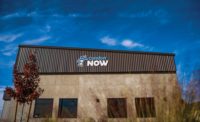Insulation and HVAC Work Together to Keep Occupants Comfortable
Greater efficiency and health come from quality insulation and a proper HVAC system

LESS LEAKAGE: Kate Jacobson, inside marketing manager for Amistee Air Duct Cleaning & Insulation, said that ensuring ductwork in unconditioned spaces is insulated adds more R-value and reduces air leakage. (Courtesy of Amistee)
The HVAC system of a building works hard to keep occupants cool in the summer and warm in the winter. Insulation works in tandem with the HVAC system, slowing down heat transfer from the outside of the building to within. Without insulation, the cost of heating or cooling a home would skyrocket. Air leakage in ductwork can impact the efficiency of a system, especially in regard to insulated (or uninsulated) ductwork. For those involved with insulation, some best practices can help make sure that both the HVAC system and insulation work in harmony.
Best Practices
Duct may run through unconditioned spaces, such as an attic or crawl space, and it’s important to insulate ductwork there so the homeowners aren’t losing conditioned air. In addition to this, contractors need to make sure that ducts are tight and sealed properly to avoid unnecessary energy loss or condensation problems. Plus, duct liner and duct wrap can be used to prevent acoustic discomfort, reducing noise traveling throughout a space via the building’s ventilation system.
“There are several ways of insulating ductwork, including wrapping the ductwork with insulation or more recently, using foam insulation to insulate the ductwork,” said Kate Jacobson, inside marketing manager for Amistee Air Duct Cleaning & Insulation. “Ensuring ductwork in unconditioned spaces is insulated adds more R-value and reduces air leakage. A higher R-value and less air leakage increases the performance of your HVAC system and improves the overall comfort of your home or building.”
When Amistee is evaluating a building’s insulation, the first thing they do is look for evidence of damage. Pests like raccoons, bats, other animals, and bugs can damage insulation, which means it will need to be properly removed and replaced. They will also inspect ductwork for signs of air leakage, which may include dark dirt and debris in the insulation.
Moisture damage can also sometimes be identified with a quick visual inspection, checking for evidence, like staining. Other times, insulation issues can be identified by listening to the homeowner’s information about when/where they feel discomfort and drafts. Furthermore, potential signs of problems include feeling leaking air around windows and air around electrical sockets. Using thermal imaging can give a more complete picture of where exactly discomfort is coming from in a home.
Understanding the various nuances of insulation is important to those who are working with it. It’s important to know which grade of sealant to use in certain situations, how spray foam may affect the performance of the building, and how other changes will affect system performance. For example, fiberglass insulation inserted in a wall cavity will not perform as intended if it isn’t touching all sides of the cavity, if it’s compressed, of it there are a lot of obstructions in that cavity. Working in spaces with wiring can prove to be a challenge too.
Suboptimal Insulation
Jacobson said that high energy bills are one of the most common signs that a building’s insulation may be suboptimal. Increased snowmelt in the winter months is another sign, as poor insulation results in heating your roof deck, indicating it may be time to evaluate the current insulation of your home or building.
When insulation isn’t working properly, the thermal performance on the home will drop. Homeowners may feel too hot or too cold or experience draft. Moisture issues could lead to mold growth, showing that insulation affects not only a homeowner’s physical sense of discomfort but also their overall health. In commercial settings, discomfort caused by suboptimal insulation can affect an employee’s performance and focus too.
Effects of the Pandemic
Like nearly every sector of the economy related to construction, the insulation market has been affected by the pandemic. Prices for insulation materials (cellulose, fiberglass, batt, and foam) initially only were slowly rising, but the price increases have sped up in more recent times. Supply prices have increased as well as demand.
“More homeowners are spending time at home and are taking necessary steps to increase their home efficiency and decrease their energy costs, like evaluating their insulation needs,” said Jacobson.
High demand is coming in to the insulation market, but other construction jobs are slowed down due to COVID outbreaks or manufacturing shortages.










